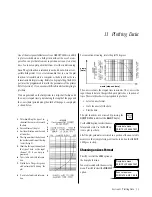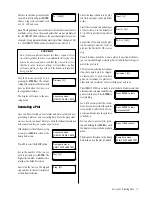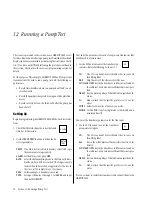
42 Section 14: Hardware Interfacing
The information contained in this section is designed to help you
interface third-party peripherals to your HERMIT. To make proper
use of this information you should be prepared to:
• Read and understand a schematic diagram.
• Research other equipment manuals for interface details.
• Run to an electronics store for parts.
• Use a soldering iron and other small tools for electronic assem-
bly.
If any of these resources are not available to you, contact In-Situ’s
service personnel for assistance, or quotes on custom cables and
interfaces.
External Power
The external power accessories supplied with your HERMIT should
satisfy most requirements for conserving the life of the internal bat-
tery pack. It is recommended that you do not use any other type of
external power accessory.
Alarm Outputs
The alarm connector contains connections for both the high and
low alarm contacts. An alarm interface cable is supplied with the
HERMIT. Do not use any other type of cable as this will compromise
the integrity of waterproof operation.
The alarm contacts and their pinouts on the back (cable) side of the
mating connector are shown below. Note that no power is supplied
by the instrument for use by the alarm circuitry. Any devices con-
nected to the alarm contacts must supply their own power. The alarm
relays are of a mechanical latching type so that the correct position
is maintained even when the HERMIT is asleep.
The interface cable color code assignments are as follows:
Function
Color
High Alarm – Normally closed
Black
High Alarm – Normally open
White or Brown*
High Alarm – Common
Red
Low Alarm – Normally closed
Blue or Orange*
Low Alarm – Normally open
Yellow
Low Alarm – Common
Green
* One or the other will be present.
14 Hardware Interfacing
Warning
In-Situ does not warrant the HERMIT against damages caused
by the interfacing of peripheral devices not provided by In-
Situ. In-Situ cannot guarantee the accuracy of the informa-
tion contained in this section, or its suitability for your
application.
Warning
Never use the relay contacts to switch more than 30 volts AC
or DC. Damage to the HERMIT could result.














































